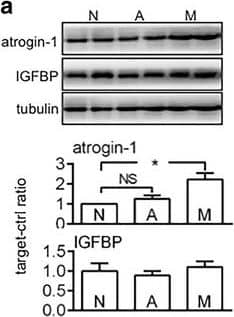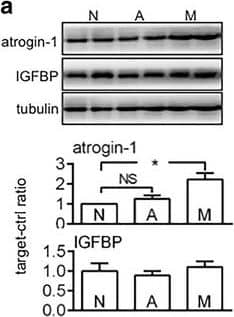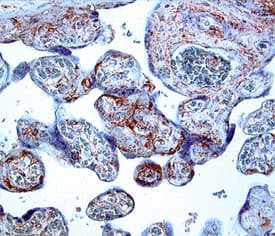Human IGFBP-3 Antibody
R&D Systems, part of Bio-Techne | Catalog # MAB305

Key Product Details
Species Reactivity
Validated:
Cited:
Applications
Validated:
Cited:
Label
Antibody Source
Product Specifications
Immunogen
Gly28-Lys291
Accession # CAA46087
Specificity
Clonality
Host
Isotype
Scientific Data Images for Human IGFBP-3 Antibody
IGFBP‑3 in Human Placenta.
IGFBP-3 was detected in immersion fixed paraffin-embedded sections of human placenta using Mouse Anti-Human IGFBP-3 Monoclonal Antibody (Catalog # MAB305) at 8 µg/mL overnight at 4 °C. Tissue was stained using the Anti-Mouse HRP-AEC Cell & Tissue Staining Kit (red; Catalog # CTS003) and counterstained with hematoxylin (blue). Specific staining was localized to cytoplasm. View our protocol for Chromogenic IHC Staining of Paraffin-embedded Tissue Sections.Detection of Mouse IGFBP-3 by Western Blot
The effect of tumour carriage on skeletal muscle Skeletal-muscle samples were obtained from normal athymic mice (group N, n = 14) and from those that carried MiaPaCa2 (group M, n = 10) or AsPC1 cells (group A, n = 13). Western blots were performed to determine atrogin-1 (a), IGFBP-3 (a), myosin (b), and MURF1 (b), using beta-tubulin as a loading control. The blots are representative data. The histograms show the results of all mice (See n in the parentheses). *P < 0.05, NS: not significant Image collected and cropped by CiteAb from the following publication (https://bmccancer.biomedcentral.com/articles/10.1186/s12885-018-4271-3), licensed under a CC-BY license. Not internally tested by R&D Systems.Detection of Mouse Human IGFBP-3 Antibody by Western Blot
The effect of tumour carriage on skeletal muscle Skeletal-muscle samples were obtained from normal athymic mice (group N, n = 14) and from those that carried MiaPaCa2 (group M, n = 10) or AsPC1 cells (group A, n = 13). Western blots were performed to determine atrogin-1 (a), IGFBP-3 (a), myosin (b), and MURF1 (b), using beta-tubulin as a loading control. The blots are representative data. The histograms show the results of all mice (See n in the parentheses). *P < 0.05, NS: not significant Image collected and cropped by CiteAb from the following publication (https://pubmed.ncbi.nlm.nih.gov/29609556), licensed under a CC-BY license. Not internally tested by R&D Systems.Applications for Human IGFBP-3 Antibody
Immunohistochemistry
Sample: Immersion fixed paraffin-embedded sections of human placenta and human colon cancer tissue
Western Blot
Sample: Recombinant Human IGFBP-3 (Catalog # 675-B3)
Human IGFBP-3 Sandwich Immunoassay
Formulation, Preparation, and Storage
Purification
Reconstitution
Formulation
Shipping
Stability & Storage
- 12 months from date of receipt, -20 to -70 °C as supplied.
- 1 month, 2 to 8 °C under sterile conditions after reconstitution.
- 6 months, -20 to -70 °C under sterile conditions after reconstitution.
Background: IGFBP-3
The superfamily of insulin-like growth factor (IGF) binding proteins include the six high-affinity IGF binding proteins (IGFBP) and at least four additional low-affinity binding proteins referred to as IGFBP related proteins (IGFBP-rP). All IGFBP superfamily members are cysteine-rich proteins with conserved cysteine residues, which are clustered in the amino- and carboxy-terminal thirds of the molecule. IGFBPs modulate the biological activities of IGF proteins. Some IGFBPs may also have intrinsic bioactivity that is independent of their ability to bind IGF proteins. Post-translational modifications of IGFBPs, including glycosylation, phosphorylation and proteolysis, have been shown to modify the affinities of the binding proteins to IGF.
Human IGFBP-3 cDNA encodes a 291 amino acid (aa) residue precursor protein with a putative 27 aa residue signal peptide that is processed to generate the 264 aa residue mature protein with three potential N-linked and two potential O-linked glycosylation sites. Human IGFBP-3 is expressed in multiple tissues. The highest expression level is found in the non-paranchymal cells of the liver. Expression levels are also higher during extrauterine life and peak during puberty. Human IGFBP-3 is the major IGF binding protein in plasma where it exists in a ternary complex with IGF-I or IGF-II and the acid-labile subunit (ALS).
References
- Jones, J.I. and D.R. Clemmons (1995) Endocrine Rev. 16:3.
- Kelley, K.M. et al. (1996) Int. J. Biochem. Cell Biol. 28:619.
- Spagnoli, A. and R.G. Rosenfeld (1997) Curr. Op. Endocrinology and Diabetes 4:1.
Long Name
Alternate Names
Gene Symbol
UniProt
Additional IGFBP-3 Products
Product Documents for Human IGFBP-3 Antibody
Product Specific Notices for Human IGFBP-3 Antibody
For research use only


